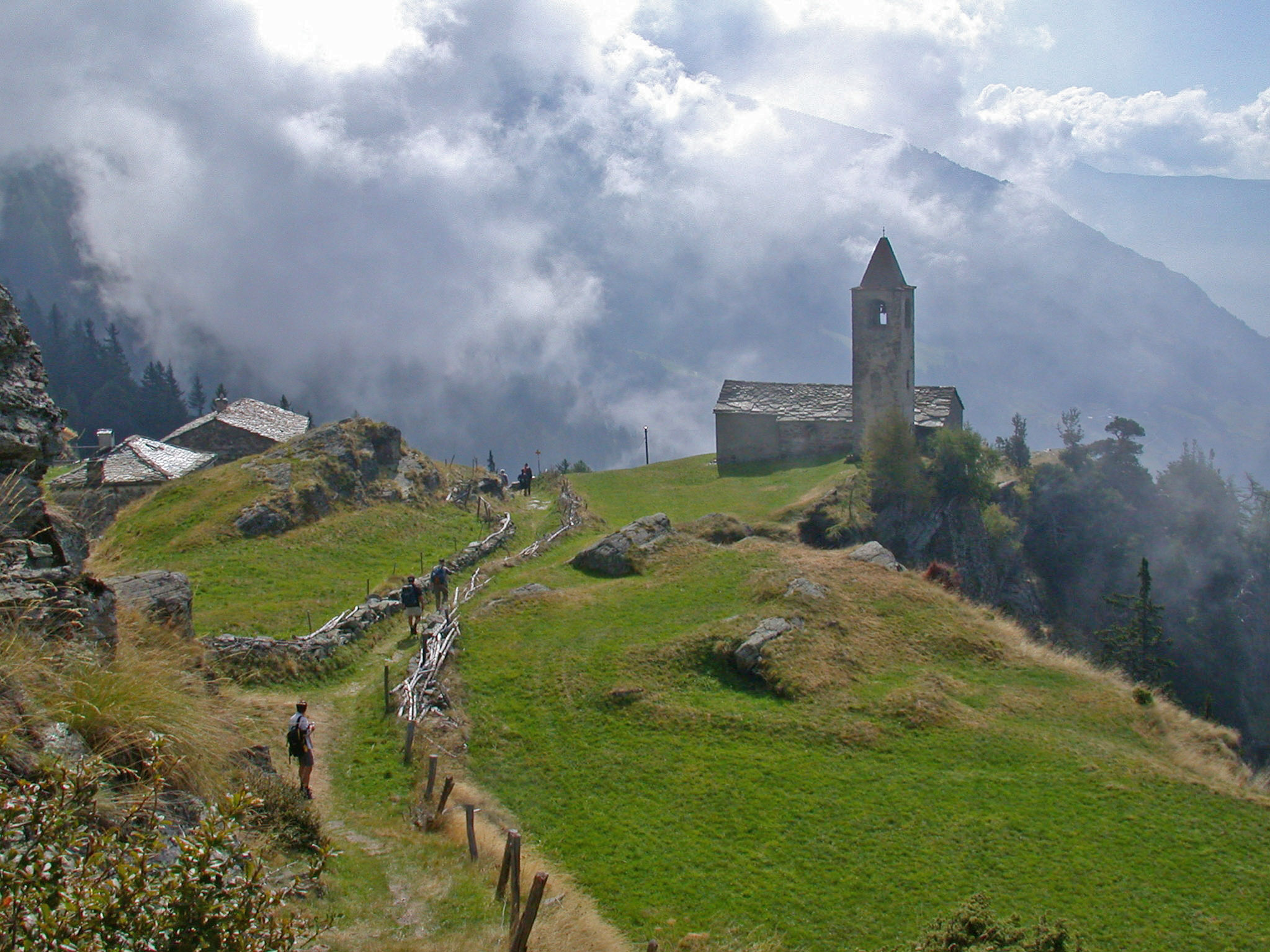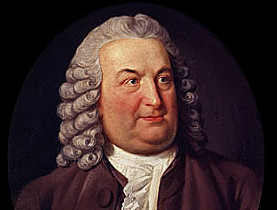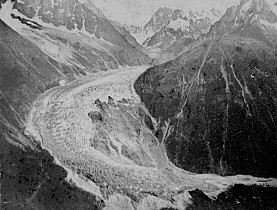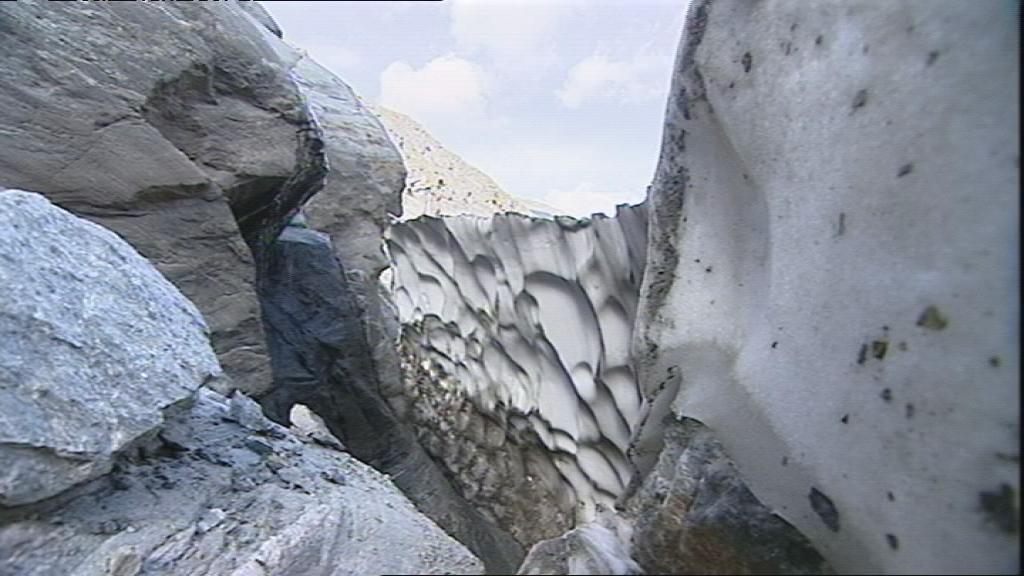“Simply follow the trail of horse dung”

“Most travellers wish to see a lot of remarkable things in a short time,” wrote Jakob Samuel Wyttenbach in one of the very first guide books to the Bernese Oberland, published in 1777.
He recommended the route from Grindelwald over the Grosse Scheidegg pass and down to Meiringen as a trip “full of magnificent objects which can be done quite comfortably and with no danger”. His advice still stands today, and the route has remained very popular.
swissinfo.ch retraced the walk, history books in hand, and speaking to hikers doing the same trail today.
“There’s no need to hire a guide,” said Baedeker’s guidebook in 1852. “One may simply follow the trail of horse dung.” Where once visitors had no choice but to walk or go by horse or mule, today many cycle – or cheat by taking the hourly post bus.
“The road is very tiring, especially when done on foot, but it is not at all dangerous,” wrote Hans Ottokar Reichard, councillor to the Duke of Saxe-Gotha-Altenburg, in a guidebook to Switzerland he produced in 1793. Reichard calculated seven or eight hours for the whole distance – while Murray’s guidebook of 1865 thinks it takes only six hours of “fast walking”.
But who wants to walk fast in such surroundings?
Dorothy Wordsworth, sister of the poet William, recalled in her journal of the trip she made to the Continent with her brother and sister-in-law, Mary, in 1820: “We made a lingering journey up the breast of the mountain, often pausing to look round. The Pikes of the Jungfrau being left behind, to our right rose up the Schreckhorn, or pike of fear.”
Slow up
The Wordsworth party took their time. Dorothy and Mary set off walking, while William, a friend and their guide followed later by mule, taking the luggage. For the kind of extended trip they were making – no quickie package holidays in those days – the amount of luggage must have been quite considerable.
One advantage of slow travel is that they came into contact with the locals. Dorothy evidently found this charming.
“A fairy being appeared before us, a child of not more than four years old,” she wrote of one encounter. The little girl offered each of the two women a posy “a work performed with a shy struggle (perhaps it was her first effort in barter or begging)”.
The German philosopher Friedrich Hegel, passing the same way in 1796, was less enchanted.
“Children assail you, offering flowers, strawberries etc., or simply begging,” he wrote. Reichard noted that it was easy to make “a rich collection of crystal, quartz, alpine plants and chamois horns”, since the traveller was soon surrounded by children eager to sell such things.
Things hadn’t changed by the time Murray’s guidebook was published in 1865.
“The younger females pick up a few halfpence by singing Ranz des Vaches [typical folk songs] at the inns, and most of the children are beggars – occupations arising from the influx of strangers into the valley, which has exercised an injurious influence upon its morals and ancient simplicity of manners,” it warned.
Not surprisingly, there is none of this to be seen today. The manageress of the busy Wetterhorn hotel looked surprised when asked whether there is still an alphorn player who wakes “a remarkable echo” in the mountains as Muirhead’s guidebook mentions as late as 1948. “I don’t know anything about that,” she said.
When swissinfo.ch asked foreign hikers following the same path if they had met many Swiss people, most had done no more than exchange greetings.
“I’d really like to have a bit more chance to talk to them,” said one German walker. “I was thinking that if we bought some cheese or something, perhaps we’d strike up a conversation.”
There was a time when all travellers bought cheese, milk and cream from the locals – not least because there was little else available en route. The provision of food was strictly controlled by the authorities in Bern.
In 1826, when Jakob Bysäth, the owner of the mineral baths at Rosenlaui, halfway between the Grosse Scheidegg and Meiringen, applied for permission to sell food to travellers, innkeepers at the two ends of the route immediately objected – unsuccessfully – on the grounds that “milk, bread and other things can be obtained in many herdsmen’s huts, so Mr Bysäth’s business is not filling any kind of gap”.
The Rosenlaui mineral baths have long disappeared, but the hotel and restaurant – greatly expanded over the years – is flourishing.
Dorothy Wordsworth was delighted with the “simple goodwill” of the shepherds with whom the party ate, and their “stores proffered without reserve” – but the cynical Hegel had quite a different take.
“By leaving travellers free to pay whatever they choose, they hope to receive more than the value of their goods,” he wrote, claiming that anyone who offered too little would soon be told the real price.
Hardly a dilemma facing the modern tourist. In any case, visitors from abroad are no longer seen as endless sources of wealth. Many of the ones swissinfo.ch spoke to lamented the poor exchange rate which makes Switzerland so expensive for them. The only semi-complaint came from one visitor, charged SFr3 ($3.1) for a glass of hot water. But even he said he was very happy with his trip, and hoped to come back.
Mountains and glaciers
The conditions of travel may have changed considerably over the past 200 years, but what about the reasons for visiting? The chief attraction for the early tourists was the glaciers.
There was some debate about whether Grindelwald or Chamonix was a better destination in this respect, but it was generally agreed that the advantage of Grindelwald was that its two glaciers were much more accessible, with the lower glacier extending almost to the village. But they could be a bit disappointing.
Hegel said there was “nothing interesting” about them; even someone as generally positive as Dorothy Wordsworth wrote of her first view of the Lower Grindelwald glacier: “It resembles a mass of dingy snow remaining in a hollow after a hasty spring thaw”.
But beauty is in the eye of the beholder. Marc Théodore Bourrit of Geneva, writing in 1787, enthused over “their pyramids of transparent ice, looking like cities built of crystal or porcelain”.
If they were disappointing then, what must they be now? They have retreated so far as to have practically disappeared. Even within living memory the difference is striking.
“When we came here 30 years ago there was a natural cave in the ice,” said one French hiker. “Now the ice has melted. It doesn’t make me feel good, but that’s nature.”
“Nature will outlive us all.”
The Oberland tour
The mountains were regarded mainly as a dangerous obstacle until the 18th century and outsiders did not go there for pleasure.
Attitudes started to change after the publication of the poem “The Alps” by the scholar Albrecht von Haller in 1732, in which he extolled the virtues of the simple mountain people. The poem, translated in several languages, was a sensation throughout Europe.
The pastor Samuel Wyttenbach was inspired by Haller to travel in the Bernese Oberland and to carry out research. His writings helped make the area better known abroad and to attract the first foreign visitors.
The earliest visitors to the Alps included the German poet Goethe who accompanied his employer, the Duke of Weimar, on a tour that took them to Grindelwald and over the Grosse Scheidegg in 1779.
The pastoral idyll was given a boost by the hugely successful Unspunnen festival of “herdsmen’s games” near Interlaken in 1805, which attracted visitors from all over Europe.
The stated aim of the festival was: “To revive the simple traditions and pleasures of our forefathers… creating new bonds of friendship between … countryside and city dwellers.”
The authorities in Bern wanted to show that the people of the area were happy to be returned to Bernese rule after the abolition of canton Oberland, created after the French invasion of 1798.
The main attractions on Grindelwald-Meiringen route were the two glaciers at Grindelwald and the one at Rosenlaui, and the Reichenbach Falls near Meiringen.
At the end of the 19th century the falls were used by British author Sir Arthur Conan Doyle – who knew the region well – to kill off his famous creation, Sherlock Holmes, who fell over the edge, locked in mortal combat with arch-villain Moriarty.
ViaStoria is behind the award-winning Cultural Routes of Switzerland project, a selection of 12 routes highlighting specific aspects of Swiss history.
The routes are based on the inventory of historic transport routes (IVS) which was drawn up at Bern University over a period of 20 years.
ViaStoria, the Centre of Transport History, is a spin-off from the university.
Hikers can buy packages including hotels, transport of luggage, documentation, etc, or can follow the routes by themselves.
The Cultural Routes project is supplemented by Regional Routes (ViaRegio), which concentrate on smaller areas. The hike from Meiringen to Grindelwald is part of the “Hike around the Jungfrau-Aletsch World Heritage Region”.

In compliance with the JTI standards
More: SWI swissinfo.ch certified by the Journalism Trust Initiative




You can find an overview of ongoing debates with our journalists here. Please join us!
If you want to start a conversation about a topic raised in this article or want to report factual errors, email us at english@swissinfo.ch.